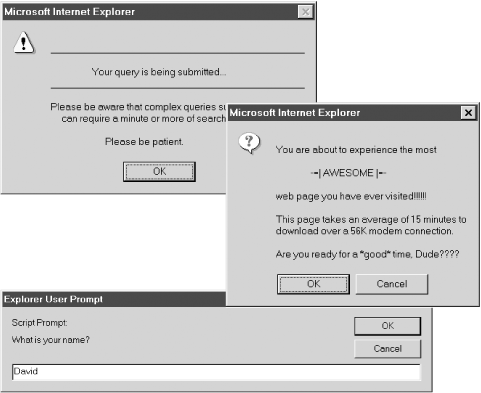Simple Dialog Boxes
Three commonly used Window methods are
alert( )
, confirm( ), and
prompt( ). These methods pop up simple dialog
boxes. alert( ) displays a message to the user,
confirm( ) asks the user to click an Ok or Cancel
button to confirm or cancel an operation, and prompt( ) asks the user to enter a string. Sample dialog boxes
produced by these three methods are shown in Figure 13-1.

Figure 13-1. alert( ), confirm( ), and prompt( ) dialog boxes
Note that the text displayed by these dialog boxes is plain text, not HTML-formatted text. You can format these dialog boxes only with spaces, newlines, and various punctuation characters. Adjusting the layout generally requires trial and error. Bear in mind, though, that the dialog boxes look different on different platforms and in different browsers, so you can’t always count on your formatting to look right on all possible browsers.
Some browsers (such as Netscape 3 and 4) display the word
“JavaScript” in the titlebar or upper-left corner of all
dialog boxes produced by alert( ),
confirm( ), and prompt( ). Although designers find this annoying, it should be considered a feature instead of a bug: it is there to make the origin of the dialog box clear to users and to prevent you from writing Trojan-horse code that spoofs system dialog boxes and tricks users into entering their passwords or doing other things that they shouldn’t ...
Get JavaScript: The Definitive Guide, Fourth Edition now with the O’Reilly learning platform.
O’Reilly members experience books, live events, courses curated by job role, and more from O’Reilly and nearly 200 top publishers.

